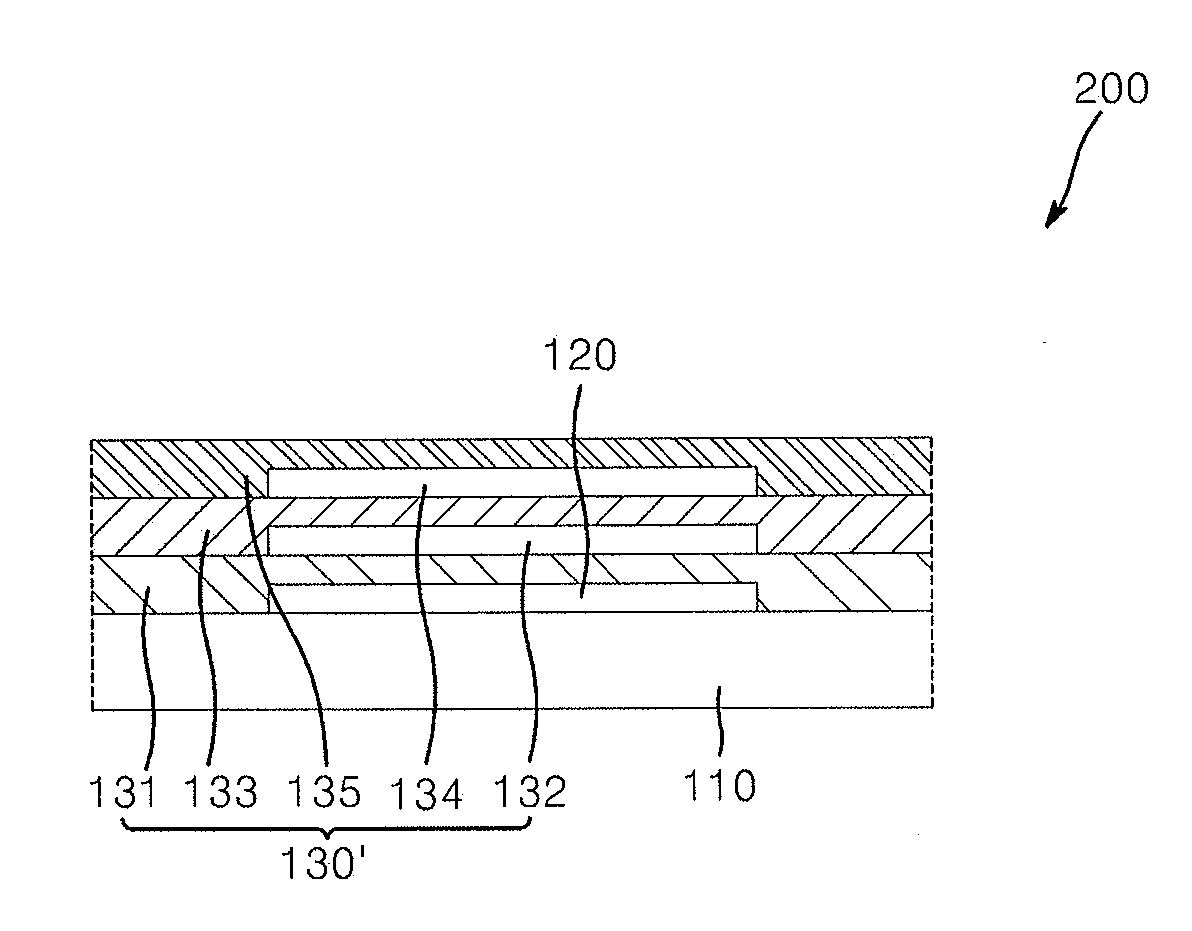Organic light emitting diode display apparatus
a light-emitting diode and display device technology, applied in the field of organic light-emitting diode display devices, can solve the problems of high resistance of light-emitting diodes, organic light-emitting diodes are vulnerable to moisture and/or gas, and light-emitting diodes can suffer from delamination, etc., to achieve excellent transparency, improve reliability in elapsed time, and secure reliability
- Summary
- Abstract
- Description
- Claims
- Application Information
AI Technical Summary
Benefits of technology
Problems solved by technology
Method used
Image
Examples
example 2
Preparative Example 2
[0145]A monomer (molecular weight: 584.92 g / mol) represented by Formula 4 was prepared in the same manner as in Preparative Example 1 except that 21 g of 3,3-diphenyl-1,1,5,5-tetramethyltrisiloxane was used instead of 25 g of 3-phenyl-1,1,3,5,5-pentamethyltrisiloxane and 30.2 g of methacryloyl chloride was used instead of 34.3 g of acryloyl chloride. The obtained monomer had a purity of 96% as determined by HPLC. (1H NMR: δ7.52, m, 6H; δ7.42, m, 4H; δ6.25, d, 2H; δ6.02, dd, 2H; δ5.82, t, 1H; δ5.59, d, 2H; δ3.86, m, 4H; δ1.52, m, 4H; δ0.58, m, 4H; δ0.04, m, 12H)
example 3
Preparative Example 3
[0146]A monomer (molecular weight: 646.99 g / mol) represented by Formula 5 was prepared in the same manner as in Preparative Example 1 except that 21 g of 3,3-diphenyl-1,1,5,5-tetramethyltrisiloxane was used instead of 25 g of 3-phenyl-1,1,3,5,5-pentamethyltrisiloxane. The obtained monomer had a purity of 94% as determined by HPLC. (1H NMR: δ7.61, m, 6H; δ7.12, m, 4H; δ6.25, d, 2H; δ6.02, dd, 2H; δ5.82, t, 2H; δ3.87, m, 4H; δ1.54, m, 4H; δ0.58, m, 4H; δ0.02, m, 12H).
[0147]Details of components used in Examples and Comparative Examples were as follows.
[0148](A) Non-silicon-based di(meth)acrylate: (A1) 1,12-dodecanediol dimethacrylate (Sartomer Co., Ltd.), (A2) 1,10-decanediol dimethacrylate (Shin Nakamura Chemical Co., Ltd.).
[0149](B) Silicon-based di(meth)acrylate: (B1) monomer of Preparative Example 1, (B2) monomer of Preparative Example 2, (B3) monomer of Preparative Example 3.
[0150](C) Mono(meth)acrylate: (C1) HRI-07 (Daelim Chemical Co., Ltd.), (C2) benzyl me...
example 1
[0154]47.8 parts by weight of (A1), 28.7 parts by weight of (B1), 19.2 parts by weight of (C1) and 4.3 parts by weight of (D) were placed in a 125 ml brown polypropylene bottle, followed by mixing at room temperature for 3 hours using a shaker, thereby preparing an encapsulating composition (viscosity at 25° C.: 21 cPs).
PUM
| Property | Measurement | Unit |
|---|---|---|
| thickness | aaaaa | aaaaa |
| height | aaaaa | aaaaa |
| thickness | aaaaa | aaaaa |
Abstract
Description
Claims
Application Information
 Login to View More
Login to View More - R&D
- Intellectual Property
- Life Sciences
- Materials
- Tech Scout
- Unparalleled Data Quality
- Higher Quality Content
- 60% Fewer Hallucinations
Browse by: Latest US Patents, China's latest patents, Technical Efficacy Thesaurus, Application Domain, Technology Topic, Popular Technical Reports.
© 2025 PatSnap. All rights reserved.Legal|Privacy policy|Modern Slavery Act Transparency Statement|Sitemap|About US| Contact US: help@patsnap.com



